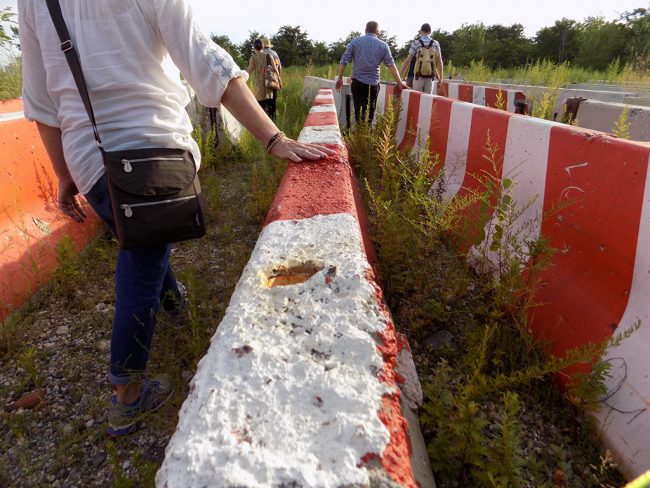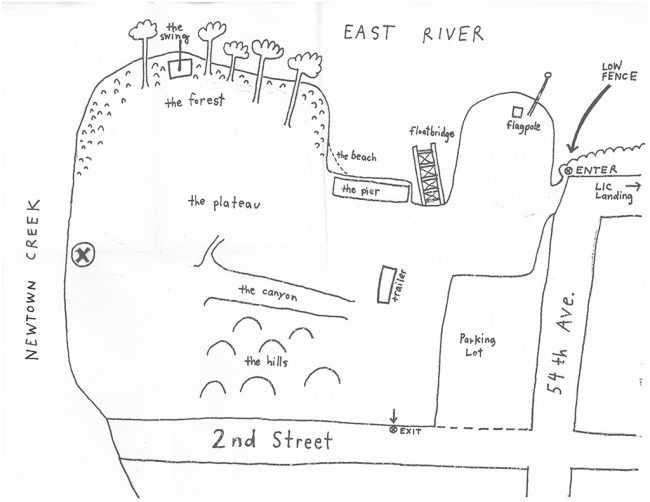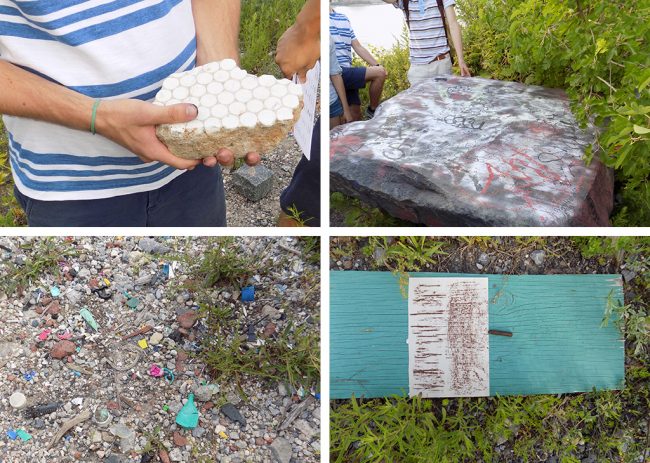
We are celebrating 15 years — and counting — of stories that are deeply researched and deeply felt, that build a historical record of what the city has been.
We are celebrating 15 years — and counting — of stories that are deeply researched and deeply felt, that build a historical record of what the city has been.

Endangered Surfaces walk participants get in touch with Hunters Point South in Long Island City, Queens.
Hunters Point South Park, located in Long Island City directly over the entrance to the Midtown Tunnel, is hardly two years old. But the waterfront space, with its synthetic green, café pavilion serving craft burgers and beer, and promenade with impressive views of Midtown Manhattan, has quickly become exceedingly popular. Most folks who flock to these amenities, however, don’t seem to pay much attention to the wild landscape that abuts its pristine design. On a muggy Sunday afternoon in late August, I joined local artists and urban enthusiasts for a semi-guided exploration of this publicly owned “post-human” space as part of Chance Ecologies, a public art project to document the wild parcel before it’s developed.
The story of the Hunters Point peninsula follows a familiar script among formerly industrial waterfront spaces in New York City: it is entirely man-made. In 1852, developers bulldozed a large hill into the East River to create more real estate on which to build factories and train yards. Later a large sugar refinery occupied the site until its demolition around World War II, thus layering new landfill upon old. A printing plant and distribution warehouse subsequently operated there for brief stints. They were its last tenants: Hunters Point has stood more or less abandoned since the late 1980s and, in the meantime, been reclaimed by nature.
Plans to redevelop the site date back to the time of its abandonment, but few gained traction until very recently. The first phase of its development, initiated by the NYC Economic Development Corporation and completed in 2013, included the waterfront park, over 900 units of (mostly affordable) housing, and new retail space. Phase Two, scheduled to begin later this year, includes more of the same for the southern parcel, the area that Chance Ecologies is exploring until development commences.
The two artists I joined, Chris Kennedy and Ellie Irons, are interested in documenting the physical face of Hunters Point through an atlas of “endangered” surfaces that will disappear with implementation of Phase Two. Before we set off into the “re-wild,” as they termed the southern, undeveloped parcel, Kennedy led us in an introductory exercise. We spent a few minutes with eyes closed, bringing our attention to each part of our bodies and aligning them with our minds so as to more deeply connect with the surrounding space.
The group split off in pairs and, using scrap paper and colored artists’ charcoal, made rubbings of nearby surfaces in the formal park. Five minutes later, we reconvened and shared the unique patterns and textures of the surfaces we’d archived: the hexagon-tiled concrete walkway, a wooden patio, tree bark, cobblestones, and a small fence made of rope. Though the rope did not easily lend itself to a two-dimensional relief, wrapping the paper around it created a series of wonderful spiral shapes.
Collecting these amateur etchings may seem trivial, but the activity undoubtedly left me something to chew on. In a dense urban environment like New York City, our senses are constantly over-stimulated: taxis and street vendors compete for our aural attention; cigarette smoke and hotdog scents fill our nostrils; advertisements, fellow pedestrians, and an array of vehicles crowd our sightlines. However, except for incidental elbow rubbing with that sweaty dude on the subway, our tactile sense is less often engaged. We may frequent the same urban spaces every day yet never stop to actually feel them. Thinking about and recording the array of surfaces that surround us prodded me to experience the city through an entirely different lens; this curiosity stayed with me long after I left Hunters Point.

Hand-drawn map of the Hunters Point South rewild, illustrated by Chance Ecologies collaborator Daniel Campo
The designed park sufficiently cataloged, Kennedy and Irons led us off the pedestrian promenade and toward a three-foot high chain-link fence, the threshold to the re-wild. In the waterfront park, surrounded by hundreds of people, we’d been seemingly ignored. But as we helped one another hop the fence, ogling ensued. One woman approached and asked, “Can you get somewhere by hopping the fence?” “Depends on what you mean by ‘somewhere,’” Irons smartly responded. This passerby could only understand our trek into weeds and thickets as a way to reach a specific location with a specific end-use. The clean delineations of the park outside between where you sit, eat, walk, or play might have prescribed this outlook of endpoints. But the transitory, ambiguous space we were entering charted a break from those routines and an opportunity to be more present and engaged.
That woman did not join us as we began to explore the network of desire paths through the wild park. Unlike the new park’s concrete walkways, defined for a user by designers, these paths were defined by the user. The multiple people who created them had made conscious and physical effort to carve fluid, organic ways through the thickets and rocks. The heavily manicured, produced park seemed to leave little room for this kind of human intervention.

“Endangered” surfaces, clockwise from top left: chunk of bathroom tile, graffitied rock ledge, painted wooden board, bits of plastic and spontaneous plant life
We came to a clearing and split up again to survey surrounding surfaces. The diversity here relative to the homogenous surfaces of the waterfront park quickly became evident. Signs of human presence manifested in a very different way. Beer cans, empty bags of potato chips, random wooden planks, a chunk of bathroom tile, and bottle caps were spread across the ground, but in this setting they did not really seem to be “trash.” The forgotten nature of the space welcomed these artifacts; they seemed to fit in. Trees and weeds sprouted up through very poor soil, filled with rocks and other debris, defying odds to survive. The value of nature is typically based upon its perceived beauty, but the tenacity of these spontaneous urban plants proved beautiful in this less-than-ideal environment.
After an hour or so exploring the twelve-acre space with little interruption from others, I recognized that part of its allure was its relative inaccessibility. The waterfront park produced passiveness, but the wild park, from jumping the fence to navigating at times unstable ground, required me to immerse myself in the landscape. I had to make a conscious effort to move through space, and therefore felt my surroundings in a much more visceral way. Undistracted because of the barriers to entry and engaged in order to navigate the re-wild’s roughness, I subsequently developed a much deeper, more personal connection with the site than I had in the new park.
With dusk arriving, Kennedy and Irons ended our endangered surfaces walk at the edge of Newtown Creek. Completely shielded from the hustle and bustle of the new Hunters Point South, with unobstructed views of Lower Manhattan and Brooklyn, we watched the sun set. We rescanned our bodies and minds to notice any changes that came up during our hour-long excursion. I could feel the blood circulating through my veins, my feet firmly planted on the ground, beads of sweat on my forehead, and the raw skin on my arms from where I had brushed through thickets and clawing branches.
After a few minutes of this quiet meditation I opened my eyes to appreciate this rare, fleeting landscape. We were in the heart of the city yet isolated by seemingly wild nature. I wondered how much longer this space would remain in this raw form, before the trucks and construction crews rolled in to begin the next chapter of its complicated life.
I soon found out. After Chance Ecologies wrapped their workshops at the end of August, construction began. Now, some of the larger trees remain, but most of the site’s landscape and plant life has been completely leveled, rendering the “endangered” surfaces now “extinct.”
This makes me appreciate the efforts behind Change Ecologies even more. We need not lament the loss of each of these spaces when the city clearly benefits, in this case through much needed affordable housing. Instead, it is doubly important to turn nostalgia for landscapes like Hunters Point South into preservation of their history and character so people can connect with them long after their physical face has been altered.
Chance Ecologies is a publicly generated art project to research and document the industrial/wild landscapes at Hunters Point. Produced by Amplifier Inc. and Radiator Gallery, local artists and urbanists explored the site and led a series of public walks, talks, and workshops during the month of August. The participating artists, including Kennedy and Irons, will exhibit their work and findings at Radiator Gallery in Long Island City from December through January (exact dates TBA).
Ben Pardee is an urbanist, hip-hop enthusiast, and yogi. He is a project assistant on Urban Omnibus and blends his deep Texan pride with Yankee sensibilities.
Photos by the author unless otherwise noted.
The views expressed here are those of the authors only and do not reflect the position of The Architectural League of New York.